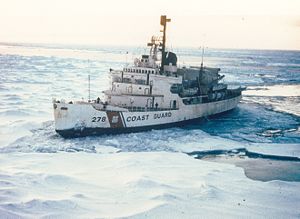Wind class icebreaker

|
|
| Class overview | |
|---|---|
| Builders: | Western Pipe and Steel Company (WPS), San Pedro, California |
| Operators: | United States Coast Guard, Royal Canadian Navy Canadian Coast Guard |
| Completed: | 8 |
| Scrapped: | 8 |
| General characteristics | |
| Type: | Icebreaker |
| Displacement: | 6,500 short tons (5,900 metric tons) (full load) |
| Length: | 269 ft (82 m) |
| Beam: | 63 ft 6 in (19.35 m) |
| Draft: | 25 ft 9 in (7.85 m) |
| Installed power: | Six Fairbanks-Morse 10-cylinder diesel engines |
| Propulsion: |
|
| Speed: | 13.4 knots (24.8 km/h; 15.4 mph) (maximum) |
| Range: | 32,485 mi (52,280 km) at 11.6 knots (21.5 km/h; 13.3 mph) |
| Complement: | 219 officers and men |
| Armament: |
|
| Aircraft carried: | 1 Grumman J2F Duck seaplane (as built) |
| Aviation facilities: | Aft turret replaced by retractable hangar on aft helicopter deck after WW2 |
The Wind-class icebreakers were a line of diesel electric-powered icebreakers in service with the United States Navy, United States Coast Guard, Royal Canadian Navy, Canadian Coast Guard and Soviet Navy from 1944 through the late 1970s. They were very effective ships: all except Eastwind served at least thirty years, and Northwind served in the USCG continuously for forty-four years. Considered the most technologically advanced icebreakers in the world when first built, the Wind-class icebreakers were also heavily armed; the first operator of the class was the United States Coast Guard, which used the vessels for much-needed coastal patrol off Greenland during World War II. Three of the vessels of the class, Westwind, Southwind, and the first Northwind all went on to serve temporarily for the Soviet Union under the Lend-Lease program, while two others were built for the United States Navy and another was built for the Royal Canadian Navy; all eight vessels were eventually transferred to the United States Coast Guard and the Canadian Coast Guard.
The Wind-class ships were the first class of true icebreakers built by the United States. Gibbs & Cox of New York provided the designs with input from the Coast Guard's Naval Engineering Division. The final design was heavily influenced by studies conducted by then LCDR Edward Thiele, USCG (later RADM, and Engineer in Chief of the U.S. Coast Guard) of foreign icebreakers, namely the Swedish Ymer, built in 1931, and the Soviet Krasin.
...
Wikipedia
